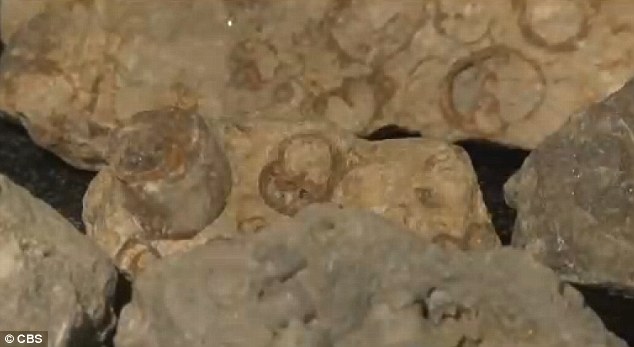20, March, 2016, By HANNAH PARRY, DAILYMAIL

Propst believe the sea snail fossils, which experts estimate are between 35 to 40 million years old, are from the time of Noah's fabled flood A creationist from Texas believes he has found proof of Noah's biblical flood in his own backyard.
Wayne Propst had been helping his aunt Sharon lay dirt near her Tyler home when he discovered a set of fossils which he says are Turritella - a type of sea snail.
He sent them to fellow creationist and 'museum curator' Joe Taylor - who believes that all life on earth dates back just a few thousand years.
Self proclaimed 'expert' Taylor has now agreed that the marine fossils come from Noah's fabled flood, the Huffington Post reports.
He has not radiocarbon dated the fossils - which can given an accurate age by measuring the isotopic decay.
But fossils take a minimum of 10,000 years to form. Most date back millions and millions of years.
However Taylor - who went to art school - runs the religion-influenced museum - Mt. Blanco Fossil - which states on its website that he is 'absolutely' sure that 'Noah took dinosaurs on the ark.'
His claims have been ridiculed by academics.
James Sagebiel, collections manager at the Texas Vertebrate Paleontology Collections, told the Tyler Morning Telegraph that Propst's fossils are actually millions of years old.
'The rocks there are about 35-40 million years old, and these little turret snails are commonly found in marine rocks of that age,' Sagebiel said. 'It's not unusual.'
He added that millions of years ago, Texas would be been coastline and home to such sea snails.
However, Propst still believes in the biblical flood, in the book of Genesis, which describes how the entire world was flooded but re-populated from two of each animals taken aboard Noah's ark.
'From Noah's flood to my front yard, how much better can it get?' Propst said.
'Who else can say they have a front yard full of Noah's dirt?
Last month, scientists discovered a new set of fossils which dates some of the first vertebrates on earth back some 20million years earlier than previously thought.
The remains, discovered in Siberia, date back more than 500million years and are being hailed as a significant advance in 'our understanding of the evolution of animals'.
The ancient marine organisms possess a 'complex constitution' and are believed to be the oldest in the world, predating finds in China and Namibia, which had a simpler structure.
Detailed analysis is now underway to confirm the initial scientific conclusions on the age and significance of the vertebrates, which were found on the banks of the Maya River in Yakutia, also known as the Sakha Republic, reported The Siberian Times.
The fossils are said to resemble fragments of snail shells.
Professor Zhu Maoyan, of Nanjing Institute of Geology and Palaeontology, said: 'If these are indeed the oldest fossils in the world, these specimens are a treasure of a planetary scale.
Until now the first known vertebrate specimens were found in the Chengjiang locality in China, and date back to the early Cambrian.
Paleontologists had believed that vertebrates began to emerge during the late Ordovician, about 450 million years ago.
By the middle of the Silurian period - around 400million years ago - the picture is clearer: armoured jawless fish were diverse, and the first definite jawed fish had appeared
By the late Devonian, 360million years ago, early cartilaginous fish and bony fish were diversifying.
The late Devonian also marked the first tetrapods - vertebrates with true legs that could walk on land.
By about 330 million years ago, in the Mississippian, several groups of land-dwelling amphibians had appeared. The oldest known amniotes - close to the ancestry of all reptiles, birds, and mammals - appeared in the early Pennsylvanian, about 310million years ago.
From: http://www.dailymail.co.uk/news/article-3501393/Creationist-finds-marine-snail-fossils-Noah-s-flood-Texas-backyard.html
